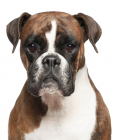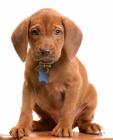Bloodhound

In my own words
So what do you want to do today? Go for a walk or jog maybe? Maybe there’ll be something interesting about, I could snout around and see what I can smell if you like? Hey, did you smell that? Wow, what was it? I’m just going to have a look. I think it was your shoes, where have you been? Perhaps you’re going somewhere? Can I come? I want to go for a walk now! There might be some new things to smell...
When we come back, the children can play with me while I have a little sleep. I don’t mind them climbing all over me really, you know, I quite like the attention. I was thinking that we could ... Oh hey, did you smell that? That smells interesting, let me just go check it out
My ideal owner(s)
Singles
Families
Joggers
Detectives
What they say about me
Easygoing
Mellow
Patient
Playful
Please read on, to find out more about me, and whether I will be someone you can be happy with for the next 12 years, or even longer!
Is this Bloodhound for you?
Test your knowledge about the Bloodhound
Information essential about the Bloodhound
Kennel Club Group:
Hound
Size:
Large: Weight Male 90 – 110 lb (41 – 50 kg) Female 80 – 100 lb (36 – 45 kg)
Height Male 25 – 27” (63 – 69 cm) Female 23 – 25” (58 – 63 cm)
Popularity:
Breed History:
The Bloodhound is one of the oldest breeds to date. Their ancestors first appeared in Europe thousands of years ago when two strains of hound—the black St. Hubert and the white Southern Hound—were brought from Constantinople. Belgian monks, bred the St. Hubert hounds during the Middle Ages, and eventually the dogs were brought to England by the Normans where they were bred to be durable hunters. Although bred as a hunter, the Bloodhound enjoys tracking most of all and they are commonly used both as a companion and a tracker, to track down game, criminals and lost children.
This breed is also known as the Flemish Hound. Throughout the world, breeds such as the American Coonhounds, Swiss Jura Hounds, Brazilian Fila Brasileiro, Bavarian Mountain Hound, and many others trace their lineage back to this ancient scent tracker. Today, all Bloodhounds are black and tan or red, but in the Middle Ages they were solid in colour. The white variety, which existed in medieval Europe, was called the Talbot Hound, which became extinct in the 1600s, but contributed to the development of many other breeds including white Boxers and tri-coloured Basset Hounds.
Bloodhounds thrive on the hunt rather than the kill and takes great pleasure in tracking. Their skills in tracking are so strong that they have earned a great reputation working as police dogs. However, today this slow mannered breed is both tracker and companion. Bloodhounds can be difficult to train despite their mellow nature, largely as they are easily distracted and always interested in any nearby strong smells rather than human command.
Character:
Bloodhounds are shy and placid but they can be sociable if given time and encouragement. They are not usually aggressive but can be wary of strangers. They have a tendency to wail at strange scents but does not bark as is often the case with other breeds of Hound.
Temperament:
This breed is very gentle and mellow. They can be shy so it is necessary to encourage socialisation from a young age. As long as they have been trained and socialised properly Bloodhounds do very well with other dogs but they are not to be trusted around small animals. With children, Bloodhounds are extremely patient and gentle as they love attention but be aware not to let young children pester them too much, as a Bloodhound will patiently accept it.
As a young dog they can be very energetic and boisterous outdoors and benefit greatly from a daily pack walk. It is important to keep a Bloodhound active both mentally and physically, otherwise they can become difficult to handle. This breed can be protective of their domain but with proper socialisation will greet visitors happily. Some Bloodhounds bark but they have a tendency to snore and howl at interesting scents. They are also droolers. Bloodhounds are able to follow any scent, including human scent which makes them excellent for tracking criminals and lost children. They have been known to follow trails over 100 hours old and can follow trails for over 100 miles. Their instinct to track scents is so strong that is unwise to keep them in an unfenced garden and off the lead because they will wander off if they pick up a trail.
Conformation:
Bloodhounds are large and powerful hound dogs with a very strong back. The head is long and narrow with a long muzzle and black nose. Their deeply sunken eyes and jowly face give them a somber but noble expression. Bloodhounds have a lot of extra skin which can hang in deep folds around the neck and head. The legs are very muscular and powerful and the tail is carried high with a slight curve above the top-line of the back. Bloodhounds stand proudly and dignified.
Coat:
The Bloodhound has a very short, hard coat that is close lying. The hair is softer on the ears and head but coarser on the rest of the body. They do not require much grooming but care should be taken to clean the ears regularly to avoid infections
Colour:
The coat can be black and tan, liver and tan and red.
Training:
Bloodhounds are very intelligent and eager to please but can also be very sensitive so they require firm but not heavy handed training. They can be easily distracted by different scents so patience and consistency is required when training. Male Bloodhounds go through puberty between the ages of one and two and during this time they can be quite a handful so you must assert your authority as pack leader to keep them under control. After the age of two they usually mellow but require consistent training and socialisation to ensure they are stimulated and prevent them from becoming timid.
Care:
Bloodhounds do not require much grooming but the folds of skin need to be cleaned regularly to avoid itchy, dry skin. Seasonally this breed can shed heavily but regular brushing will remove loose hair. Groom with a hound glove and only bathe when necessary. You can rub them with a rough towel to leave the coat gleaming. Bloodhounds have long, floppy ears so ensure that they are checked and cleaned regularly to avoid infections.
Health:
The lifespan of a healthy individual is between 10 and 12 years, which is normal for a dog of this size. If you buy from a reputable, responsible breeder, health problems should not occur. Bloodhounds are prone to bloating so try to feed them two or three small meals a day rather than one large meal. This breed can also suffer from stomach cramps and are prone to hip dysplasia, ear infections and entropion where the eyelids turn inward. Calluses can form on their joints so a padded bed is recommended and regular cleaning of the ears will help prevent infection
Exercise:
Bloodhounds need regular exercise as they have a tendency to overeat. Regular exercise in large fenced in areas will help this breed stay healthy and active, while also ensuring they do not go wandering off as they have a tendency to roam when following a trail. With regular exercise of at least 90 minutes a day this breed with thrive, but it is important to keep them mentally as well as physically active to training is essential. Bloodhounds can do okay living in an apartment as long as they are sufficiently exercised and have access to an average sized yard. They have an incredible amount of stamina, able to walk for hours on end so they enjoy hiking but be aware of their instinct to try to pick up scents as you may find it difficult to get their attention.
You may also like:
If you like Bloodhounds, you may be interested in breeds of the same size »





If you like Bloodhounds, you may like other breeds with similar characteristics »





If you like Bloodhounds, you may be interested in these other hound dogs »





Advice on choosing your breed »
Find an animal shelter or rescue home where a Bloodhound is waiting for a new home »
The following grid gives a fast track review which covers all breeds. You can apply it to help you decide if a Bloodhound is suitable for you, the environment where you live, your personality and your lifestyle. On the grid, 1= strongly disagree, and 5= strongly agree. For example, if you are looking for a dog that likes to go jogging, look down the list under Activities, and you will see that Bloodhounds love running and walking, scoring 5. If you want a playful companion, look down the same list, and you will see that Bloodhounds love to hunt, and score 5. You might like to save or print off this section and keep it for reference while you check some other breeds before making your final choice.
Be the first to rate this breed »
|
*PLEASE NOTE: All our breed profiles are general, and all dogs are individuals. Always talk to the breeders and meet the owners you are buying from. Try to meet the dog and its parents if it is a puppy in their home environment.













